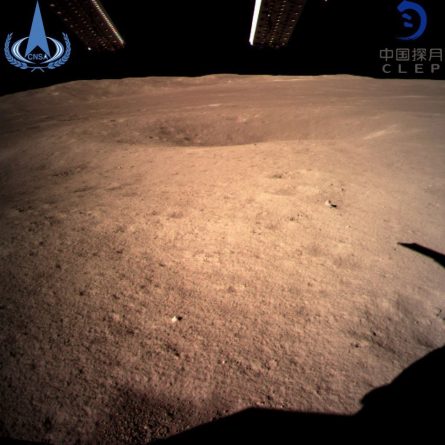Chinese state media reported that the lunar explorer Chang’e 4 landed successfully at 2:26 UTC this 3 January in the hidden face of the Moon, which had never before been explored. In this way, the Asian country has become the first nation in the history of humanity to successfully land a probe in this lunar zone.
According to China Central Television, the landing, which took place relatively close to the site predetermined, allowed to “open a new chapter” in the study of the Earth’s satellite.
The La Chang’e-4 probe has already sent the first image of the hidden face of the Moon after its landing.
On December 8, China successfully launched the Long March 3B rocket probe to explore the hidden sector of Earth’s natural satellite. The probe was named after the goddess of the Moon in Chinese mythology. It is planned to carry out measurements and collection of rocks that could reveal new details about the lunar region furthest from the Earth.
The importance of the mission of the Chang’e-4 is that the lunar sector to which it is directed has a different composition to the sites that were already explored. Yingzhuo Jia, from the Academy of Sciences of the University of China, and his working group detailed that, in addition to studying the dark side of the Moon, they will attempt a low-frequency radio astronomy study of the surface and topographic and compositional analyzes mineralogical of the region to which the ‘rover’ will arrive.

The exact point of landing is at 177.6 degrees east, 45.5 degrees south, which places it in a place almost diametrically opposite to Earth, at an equivalent latitude on Earth to that of the South Island of New Zealand . If they were 45.5 degrees north latitude it would be roughly equivalent to the latitude of Bordeaux, Turin or Venice on Earth.
The mission consists of a lander and a rover or vehicle, which are almost the same as those of the Chang’e 3 mission (the first Chinese mission to land on the Moon, a feat achieved in 2013), since in fact they were built as a backup for that mission. But they incorporate some changes, especially in the rover, with the lessons learned in the previous mission.

Between them they carry eight instruments that include several cameras, spectrometers, a radar to study the Moon below the surface, a dosimeter to measure radiation, and an instrument that will measure how the solar wind interacts with the surface of the Moon.
The lander also carries a kind of terrarium in which the growth of plants and silkworms will be studied.
But in addition the mission uses a satellite baptized like Queqiao, placed in the point Lagrange L2 of the system Earth-Moon, to a distance of between 65,000 and 85,000 kilometers of its surface so that it does of relay of communications between the lander and the control of the mission. Otherwise it would be impossible to maintain contact.
‘Lunar biosphere’
The project also includes a biological experiment that should show if it is possible to maintain life in that part of the Moon, and to that end Chang’e-4 has on board potato seeds and ‘Arabidopsis’, a plant related to cabbage and mustard, as well as silkworm eggs.
With the experiment, Beijing plans to create a small ‘lunar biosphere’. To achieve his goal, they will deposit an aluminum cylinder with the seeds and eggs on the hidden face of the Moon. The three kilogram container will contain water, air, a small camera and a transmission system so that researchers can observe the evolution of the process from Earth, to around 384,400 kilometers.
The next target of China will be to launch the Chang’e-5 probe, which will have as its mission to bring Earth samples of the Moon.
To understand what the “other side” of the Moon means, it is important to note that the Moon is in synchronous rotation around the Earth. This means that it uses the same time to translate around our planet than to rotate on its own axis, so we can not see its hidden face or “dark side”.
What is the hidden side of the Moon and why was it so complex to get there?
The hidden face of the Moon can never be seen from Earth due to a phenomenon known as “synchronous rotation”, since our satellite takes as long to turn on its own axis as to complete an orbit of the Earth.

For this reason, this face is erroneously known as “dark side”, although it is illuminated by the Sun and equally experiences both day and night. A well-known Pink Floyd song and even a movie from the Transformers series have helped popularize this error.
Previously, other spacecraft could observe this hidden face, but none landed on it. It all began with the Soviet spacecraft Luna 3, which made the first photographs of the hidden face of the Moon in October 1959. It took 29 images 66,700 km away, which showed a mountainous terrain and two dark regions.
Although over time have been sent probes to many places in space and have photographs of the hidden side of the Moon, had not landed on it. Why? It was not as easy as it seemed. Historically it was said that doing so would cause communication problems. Likewise, the interest of the countries was decreasing with time.
However, China has achieved it in a historic mission. Just as the USSR took the first photographs almost six decades ago, China has managed to descend to a crater on this side of the Moon. A moon landing that will surely deliver valuable information for scientists.
Translated by JRE
| Website
Tags: China moon space Technology





